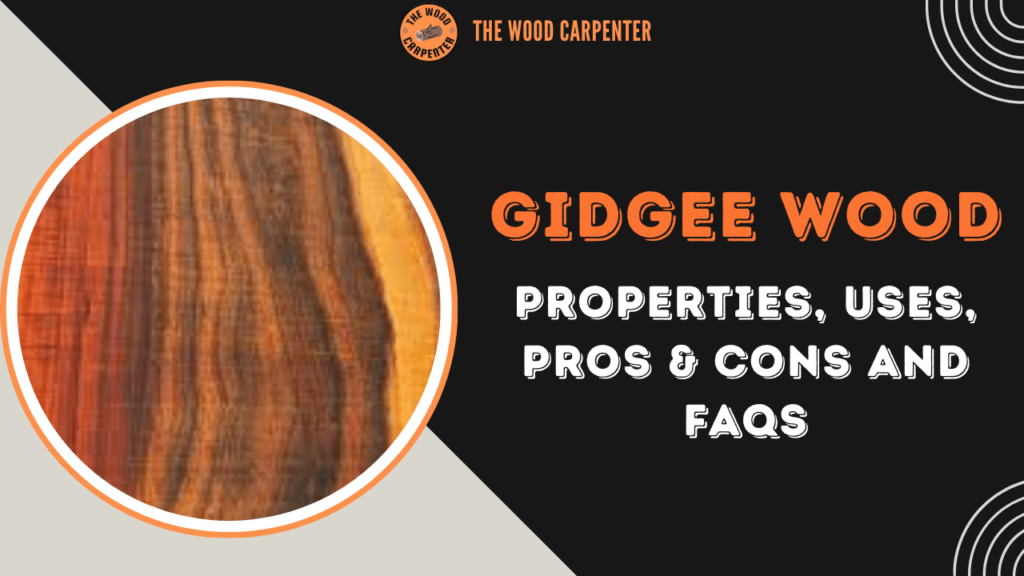
Introduction
When it comes to the hardest and most durable timbers in the world, Gidgee wood (Acacia cambagei) stands tall. Native to Australia, this dense hardwood has earned a reputation for its extreme hardness, unique beauty, and excellent durability. Woodworkers, furniture makers or wood lovers who have worked with Gidgee will know what I mean.
In this article, we will discuss everything about Gidgee wood including its appearance, properties, uses, workability, sustainability source & its pros and cons along with FAQs.
What is Gidgee Wood?
Gidgee (Acacia cambagei), also known as stinking wattle, Black Acacia, Silver Acacia, and Scrub Ironwood, is a tree native to Australia. It is usually 20–40 feet tall with trunks 1–3 feet in diameter. Yet the wood is in modest size, it produces some of the heaviest and hardest in the world.
Gidgee Wood Appearance
Heartwood: Light to dark reddish brown, often with darker streaks or curly figure (“Ringed Gidgee”).
Sapwood: Yellowish white to cream colored with a clear separation from the heartwood.
Grain & Texture: Generally straight, but may be interlocked or wavy. Texture is medium to coarse.
Unique Feature: Heartwood fluoresces under blacklight, giving it unique applications in decorative projects.
This impressive disparity of heartwood and sapwood colour, often makes Gidgee wood really pop in fine woodworking projects.

👉 In simpler terms: Gidgee is a incredibly dense, strong, and dimensionally stable, which makes it ideal for projects that require toughness and longevity.
Workability of Gidgee Wood
Gidgee is extremely hard, difficult to work. Here’s what to expect:
Machining: Very hard on tools. It needs sharp carbide blades and frequent re-sharpening.
Hand Tools: Very difficult; not for beginners.
Seasoning/Drying: Must be dried slowly to prevent checking or warping; can take months to a year depending on thickness.
Gluing & Finishing: It will accept adhesives and finishes well once properly prepared. Polishes to a beautiful, glossy surface.
Turned Objects: It will give exceptional results in turning, carving, and fine craft items if they are handled carefully.
Durability & Resistance
Natural Durability: Resistant to decay, fungi and insects.
Insect Resistance: Termite and borer resistant.
Water Resistance: Its compact grain and natural oils enables outdoor uses, even boat decks!
Fire Resistance: Density has led to some claims of excellent fire resistance.
Difference Between Gidgee & Other Hardwoods
Let’s compare gidgee wood with some popular hardwoods:
| Feature | Gidgee Wood | Acacia | Teak | Sheesham |
|---|---|---|---|---|
| Hardness | Extremely hard (4,000+ lbf) | Moderate | Hard | Hard |
| Durability | High | Medium-High | High | High |
| Grain Pattern | Unique, Ringed & Purple Varieties | Straight | Fine & Straight | Wavy & Rich |
| Price | Expensive | Affordable | Expensive | Affordable |
While acacia and teak are excellent woods, gidgee is on another level in terms of density, beauty, and longevity.
Common Uses of Gidgee Wood
Gidgee is highly used for the following reasons:
Furniture – Both indoor and outdoor luxury furniture.
Flooring – Highly durable non-slip flooring that can withstand very heavy foot traffic.
Musical Instruments – Guitar necks, woodwind parts and drum stick butts.
Tool Handles – For handles where shock resistance is necessary.
Turned Objects & Carvings – Bowls, pens and necklaces and ornaments.
Boat Building – Durable and waterproof for marine use.
Cabinetry & Joinery – High-end cabinetry and architectural features.
Pros and Cons of Gidgee Wood
✅ Pros
- Extremely Hard & Strong – One of the hardest woods in the world.
- Longevity – Will not rot, decay or be eaten by insects.
- Attractive Grain – Rich color with attractive grain.
- Quality of Finish – smooth, glossy surface.
- Variety Of Uses – Uses include flooring, instrument making.
❌ Cons
- Hard to machine: Hard on tools.
- Dries Slowly – Susceptible to splitting if not seasoned properly.
- High Weight – They are extremely heavy and are hard to move from site to site.
- Not Very Available – It’s only found in Australia and thus, not easy to find or cheap.
Sustainability and Availability
It is not currently endangered, gidgee does not appear in either CITES or the IUCN Red List. Because its natural range in Australia it is so limited, they are rare and valuable, not sold as commercial lumber often sold in small pieces.
When you are buying Gidgee, always check that it has been ethically harvested and comes from legal sources.
Frequently Asked Questions (FAQs) About Gidgee Wood
Q: Is Gidgee the hardest wood in the world?
Gidgee is one of the hardest woods, measuring 4,270 lbf on the Janka scale. While there are others such as Australian Buloke that surpass this, Gidgee still makes it to the world’s top hardwoods.
Q: What is Gidgee wood used for?
It is commonly used in furniture, flooring and cabinetry making. The grain and colours are well suited to musical instruments, tool handles, boat building and fine turning.
Q: Is Gidgee suitable for outdoor use?
Yes. It can be used outside aside from withstanding pests and naturally repelling water, but it needs to be seasoned and finished properly.
Q: Is Gidgee expensive?
Yes. Its rarity outside of Australia and challenges in extraction means it is relatively expensive, frequently sold in small sections rather than large planks.
Q: Does Gidgee cause allergies?
Like most woods, Gidgee’s wood dust may irritate skin, eyes, or respiratory system. So always use a proper dust collection and safety gear when working with it.
Gidgee Wood Charcoal
Q: Is Gidgee wood good for charcoal?
Absolutely Gidgee makes good charcoal due to high density, long burning time and consistent heat.
Gidgee Tree Identification
Q: How do you identify a Gidgee tree?
Gidgee trees are small to medium in size with a dark bark, narrow leaves and an unpleasant strong odour, especially after rain.
Gidgee Tree Smell
Q: Why does a Gidgee tree smell bad?
Gidgee is also nicknamed “Stinking Wattle” because its leaves release a pungent, unpleasant odor when they get wet.
Final Thoughts
Gidgee wood is a true Australian gem – it’s incredibly hard, tough and beautiful looking once polished. It can be a bit tricky to work with as its just so dense, but the finished effect is totally worth the effort. From fine furniture to musical instruments, Gidgee is incomparable in strength and appearance.
As a woodworker looking for a material that will last generations, Gidgee is one of the best options on the market.

